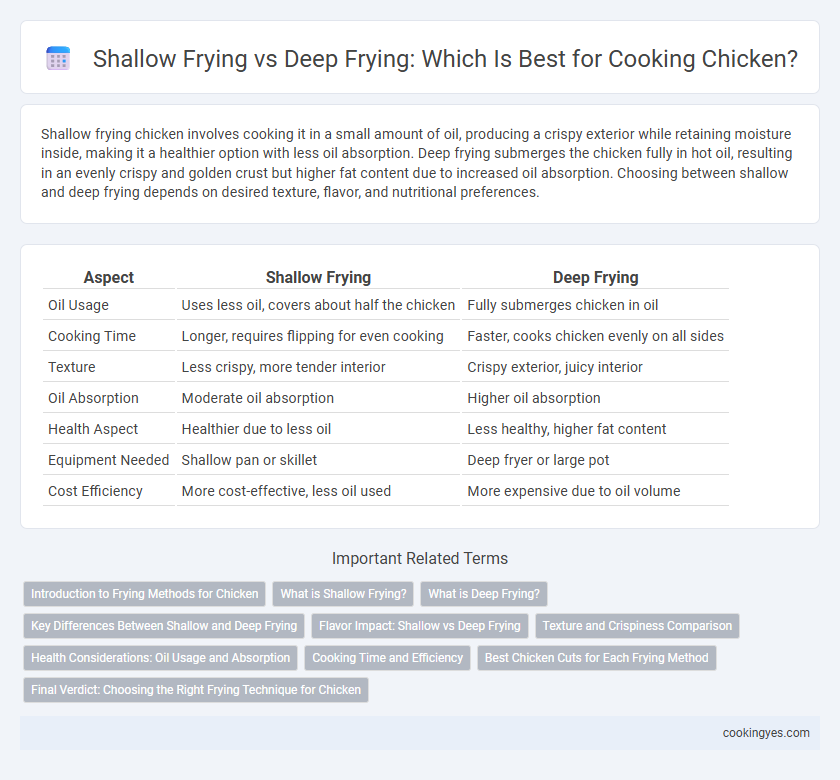Shallow frying chicken involves cooking it in a small amount of oil, producing a crispy exterior while retaining moisture inside, making it a healthier option with less oil absorption. Deep frying submerges the chicken fully in hot oil, resulting in an evenly crispy and golden crust but higher fat content due to increased oil absorption. Choosing between shallow and deep frying depends on desired texture, flavor, and nutritional preferences.
Table of Comparison
| Aspect | Shallow Frying | Deep Frying |
|---|---|---|
| Oil Usage | Uses less oil, covers about half the chicken | Fully submerges chicken in oil |
| Cooking Time | Longer, requires flipping for even cooking | Faster, cooks chicken evenly on all sides |
| Texture | Less crispy, more tender interior | Crispy exterior, juicy interior |
| Oil Absorption | Moderate oil absorption | Higher oil absorption |
| Health Aspect | Healthier due to less oil | Less healthy, higher fat content |
| Equipment Needed | Shallow pan or skillet | Deep fryer or large pot |
| Cost Efficiency | More cost-effective, less oil used | More expensive due to oil volume |
Introduction to Frying Methods for Chicken
Shallow frying involves cooking chicken in a small amount of oil, allowing for even browning and a crispy exterior while retaining juiciness inside. Deep frying fully submerges the chicken in hot oil, resulting in a uniformly crispy crust and faster cooking time. Both methods use precise temperature control, typically between 325degF to 375degF, to ensure optimal texture and flavor.
What is Shallow Frying?
Shallow frying involves cooking chicken in a small amount of oil that partially covers the food, typically in a skillet or frying pan. This method allows for a crispy outer layer while maintaining juiciness inside, using less oil compared to deep frying. Shallow frying is ideal for chicken pieces like cutlets or fillets, providing even cooking and a golden-brown crust without the greasy texture characteristic of deep-fried chicken.
What is Deep Frying?
Deep frying involves submerging chicken completely in hot oil at temperatures between 350degF and 375degF, creating a crispy exterior while locking in moisture for a juicy interior. This method ensures even cooking and a golden-brown crust by allowing oil to surround the chicken uniformly. Compared to shallow frying, deep frying uses more oil but results in a distinct texture and faster cooking time for chicken pieces.
Key Differences Between Shallow and Deep Frying
Shallow frying chicken involves cooking the meat in a small amount of oil, allowing for even browning and a slightly crisp exterior while maintaining juiciness inside. Deep frying submerges the chicken completely in hot oil, resulting in a uniformly crispy crust and faster cooking due to higher heat transfer. The key differences include oil quantity, cooking time, texture, and oil absorption, with shallow frying offering a lighter finish and deep frying providing a crunchier, more indulgent texture.
Flavor Impact: Shallow vs Deep Frying
Shallow frying chicken allows the meat to retain more natural juices, resulting in a tender texture with a subtle, crispy coating that enhances the chicken's inherent flavors. Deep frying creates a uniformly crunchy and golden crust by submerging the chicken in hot oil, producing a richer, more intense flavor profile through Maillard browning and caramelization. The choice between shallow and deep frying significantly impacts the flavor intensity and texture, with deep frying offering a more pronounced savory taste and shallow frying preserving delicate, nuanced chicken flavors.
Texture and Crispiness Comparison
Shallow frying chicken results in a firmer texture with a moderately crispy exterior due to limited oil immersion, allowing for better control over browning and moisture retention. Deep frying submerges the chicken completely in hot oil, creating an intensely crispy and evenly golden crust while locking in juiciness, but it can sometimes lead to a heavier, oilier finish. Choosing between shallow and deep frying depends on desired crispiness level and texture balance, with deep frying favored for maximum crunch and shallow frying preferred for a lighter, less greasy bite.
Health Considerations: Oil Usage and Absorption
Shallow frying chicken uses less oil and results in lower fat absorption compared to deep frying, making it a healthier cooking method. Deep frying submerges chicken entirely in hot oil, significantly increasing calorie and fat content due to higher oil absorption. Choosing shallow frying can reduce the intake of unhealthy fats and promote better heart health while still achieving a crispy texture.
Cooking Time and Efficiency
Shallow frying chicken typically takes 8 to 12 minutes, offering quicker cooking for smaller pieces with less oil usage, making it more energy-efficient for home kitchens. Deep frying requires 10 to 15 minutes at around 350degF (175degC), ensuring even cooking and crispiness but consumes more oil and energy. Efficiency depends on portion size and desired texture, with shallow frying suitable for quicker meals and deep frying preferred for larger batches or a uniformly crispy exterior.
Best Chicken Cuts for Each Frying Method
Chicken thighs and drumsticks are ideal for shallow frying due to their higher fat content and tenderness, which ensures juicy results with a crispy exterior. Breast fillets and wings are better suited for deep frying, as their leaner texture crisps evenly and cooks quickly in hot oil. Selecting the right cut enhances flavor, texture, and cooking efficiency for both frying techniques.
Final Verdict: Choosing the Right Frying Technique for Chicken
Shallow frying chicken uses less oil and results in a lighter, crisp texture ideal for smaller cuts and quicker cooking times, while deep frying provides a uniformly crispy exterior with a juicier interior, making it suitable for larger portions and classic fried chicken recipes. Nutritionally, shallow frying reduces overall fat content compared to deep frying, but deep frying ensures even cooking and maximum flavor retention. The final choice depends on desired texture, cooking convenience, and health considerations, with shallow frying favored for low-oil cooking and deep frying preferred for authentic fried chicken crispiness.
Shallow Frying vs Deep Frying for Chicken Infographic

 cookingyes.com
cookingyes.com